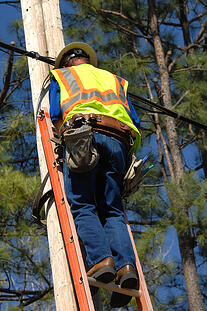Safety Counts: In the Office and on the Lines
 From Smokey the Bear to OSHA to your own mother, “safety first” is a message we have heard over and over again in our personal and professional lives. In addition, safety, as it pertains to power poles, is a huge deal—health, livelihoods and lives hang in the balance—so getting things right is of utmost importance, to everyone.
From Smokey the Bear to OSHA to your own mother, “safety first” is a message we have heard over and over again in our personal and professional lives. In addition, safety, as it pertains to power poles, is a huge deal—health, livelihoods and lives hang in the balance—so getting things right is of utmost importance, to everyone.
According to a study published by the Oregon Public Utility Commission Safety & Reliability Section, the ten most common NESC violations1 range from violations of the worker safety zone (42% of violations), to mid-span violations (10%) to needed pole transfers (8%) and ground rods not being flush or below the ground line (3%). No matter the violation however, it all comes down to taking care—of equipment and people – for the sake of the public, your attachment partners, and for the workers who are on your utility poles every day.
With that information in mind, here are a few key items to consider when it comes to safety and keeping on the good side of the NESC:
Worker Safety Zone
The worker safety zone or “neutral” space is defined as the space between the lowest electrical supply conductor or equipment and the highest communication cables or equipment. It is a zone that provides a safe working space in which communication employees can install or maintain lines. The area below this is used primarily for the placement of attachments.2
The NESC states this space be no less than 40 inches3. Any area less than this would be in violation of regulations. Unfortunately, this safety hazard apparently occurs quite regularly, given that almost half of all total violations are found to be encroachments on this valuable breathing room.
What is crowding utility workers out? It could be any number of things, but poles overloaded with misplaced, bootleg or simply too many attachments could be the culprit. Audit the utility poles you own frequently and use joint usage management software to track what is attached as well as which utility poles offer the free space necessary to keep your linemen and linewomen safe.
Joint Use Clearance Violations
Ground or grade clearance varies based on where the pole lies (from 8 feet over pedestrian walkways to 27 feet over a railroad passage, but clearance violations also pose an issue in many places. Here, as above, an audit of all poles in your system and clear, updated records on each pole via joint use management software will keep your field assets in good order.
Worker Safety Snafus
From the Lineman Barn Facebook page4, from the mouths of lineman themselves, we present a myriad of commonly observed safety violations:
-
Free climbing of poles
-
Harness leg straps
-
Working hot secondary with no gloves or leather gloves
-
Lack of use of road cones
-
Not covering dead-end shoes and jumpers
-
No hardhat
-
No safety glasses
-
Lack of proper clothing (The best one: not wearing pants in the bucket when it is hot outside!)
-
No wheel chocks for the truck
-
Not using a spotter when backing up equipment
It is scary up there—and apparently the equipment, voltage and weather conditions are only secondary to the fright that fellow employees can inflict. While no joint use software can solve managerial or training issues, proper joint use management can make a difference. Good process can help owners be better organized when it comes to the work that must be done, give better direction to employees working on their utility poles, and become more accountable when violations are uncovered.
1 http://www.puc.state.or.us/commonnescviolations.ppt
2 http://www.centerpointenergy.com/staticfiles/CNP/Common/SiteAssets/doc/10_28_13PoleAttachmentGuidelinesManual.pdf
3 http://www.nespower.com/documents/PoleAttachmentGuidelines.pdf
4 https://www.facebook.com/lineman.barn/posts/502639593098869

Comments